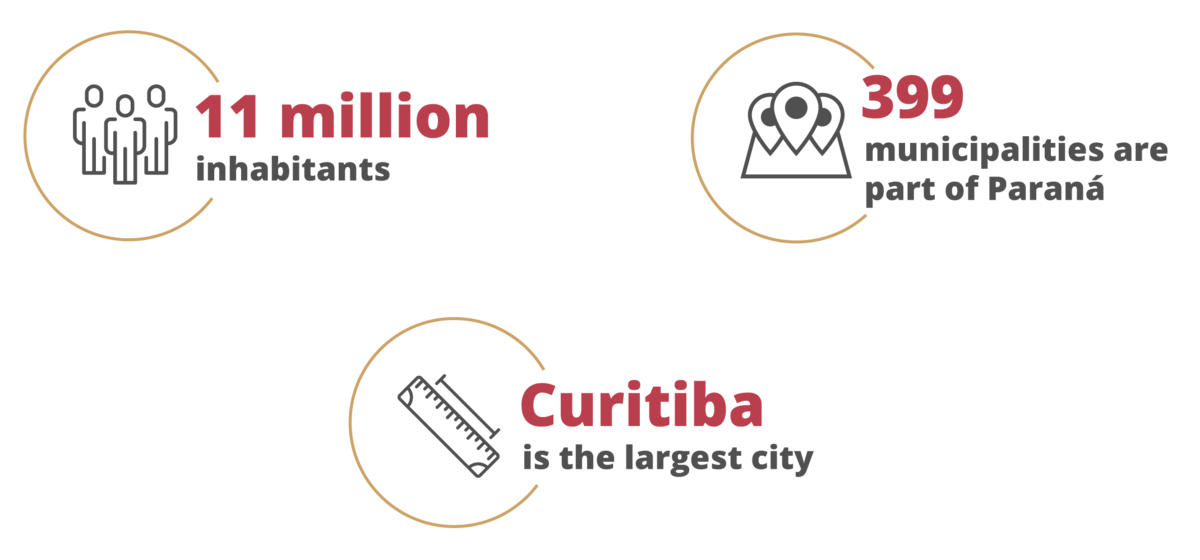WHERE WE ARE
PUCPR has campuses in three different cities within the state of Paraná: Curitiba, Londrina, and Toledo. Additionally, it boasts an international presence in Florence (Italy).
The beautiful and vibrant main campus is in Curitiba, Paraná, and is shared daily by a community of around 20,000 people, including students, faculty, researchers, and staff.
ABOUT BRAZIL

POLITICAL AND ADMINISTRATIVE DIVISIONS
Brazil comprises five central regions: North, Northeast, Central-West, Southeast, and South. PUCPR is located in the South region – the smallest area but with the best socioeconomic indicators.
NATURAL RESOURCES
Biodiversity in Brazil is among the richest in the world. Some Brazilian biomes include the Amazon Rainforest, the Brazilian Wetlands, and the Atlantic Forest.
ECONOMY
Brazil is the ninth-biggest* world economy, according to the World Bank. The country is a large producer and exporter of mineral and agricultural commodities such as iron, soy, coffee, and sugar cane. *Data from 2015.
INDUSTRIALIZATION
The most industrialized regions of Brazil are the South and the Southeast. Our industry highlights include food and beverage, oil products and biofuels, automobiles, metal minerals, chemical products, and metallurgy.
ABOUT PARANÁ


INDUSTRIES
Paraná stands out for the performance of its industries related to raw materials and manufactured goods such as automobiles, foods, oil products, and biofuels.
AGRICULTURE
The top agricultural products are soy, corn, and sugar cane. Paraná is also one of the largest grain producers in Brazil,* producing approximately 20 percent of the national production. *Data from 2013. Source: National Supply Company (Conab)
ENERGY PRODUCTION
Around 85 percent* of the electricity used in Brazil comes from renewable sources. Hydraulic generation stands for 70% of the energetic national grid. The Itaipu Power Plant, one of the world’s giant hydroelectric power plants, is located in Paraná. Its production capacity is 14,000 megawatts. Since it started operating in 1984, the power plant has produced enough energy to supply the entire planet for over a month. *Source: National Energy Balance 2013
FOREST WEALTH
The araucária tree – also called Pinheiro-do-paraná-is the symbol tree of the state. The pine nuts, a seed produced by this tree in winter, is the primary food source for the area’s Gralha-Azul bird. This bird habitually buries these seeds, helping disseminate the araucária tree.
ABOUT CURITIBA


HISTORY
Curitiba is a young city founded in 1693. Its name originated in the Guarani language, spoken by the local indigenous people, and it means “lots of pine trees” (Araucaria trees).
STRATEGIC POSITION
Curitiba locations are favorable to business. São Paulo, Brazil’s most important economic center, is 400km away. The city is an entrance to three Mercosur countries (Argentina, Paraguay, and Uruguay).
ECONOMY
Curitiba ranks fifth among Brazilian municipalities, representing 1.5% of the national Gross Development Product (GDP). In 2013, the Brazilian GDP reached over BRL 79 billion.
JOB GENERATION
Curitiba ranks sixth among Brazilian capital cities in the number of formal jobs. Most employed people work in the service and trade sectors.
ABOUT LONDRINA
Londrina is the fourth most populous city in southern Brazil, with nearly 600,000 inhabitants. Londrina is a hub for regional and national development and the campus focuses on activities related to the agribusiness. Learn more about PUCPR Londrina Campus.
ABOUT TOLEDO
The town of Toledo, located in western Paraná, is a leading grain producer in the state. Its population sums up to 130,000 inhabitants. Learn more about PUCPR Toledo Campus.
About Florence, Italy
Florence is the capital city of Tuscany and has about 380,000 inhabitants; its metropolitan area has about 1.5 million. A center of medieval European trade and finance and one of the wealthiest cities of the time, Florence is considered the birthplace of the Renaissance. The Historic Center of Florence attracts millions of tourists each year and was declared a World Heritage Site by UNESCO in 1982. The city is noted for its culture, Renaissance art and architecture, and monuments. Due to Florence’s artistic and architectural heritage, it has been ranked by Forbes as one of the most beautiful cities in the world. Learn more about PUCPR Florence at KSU.